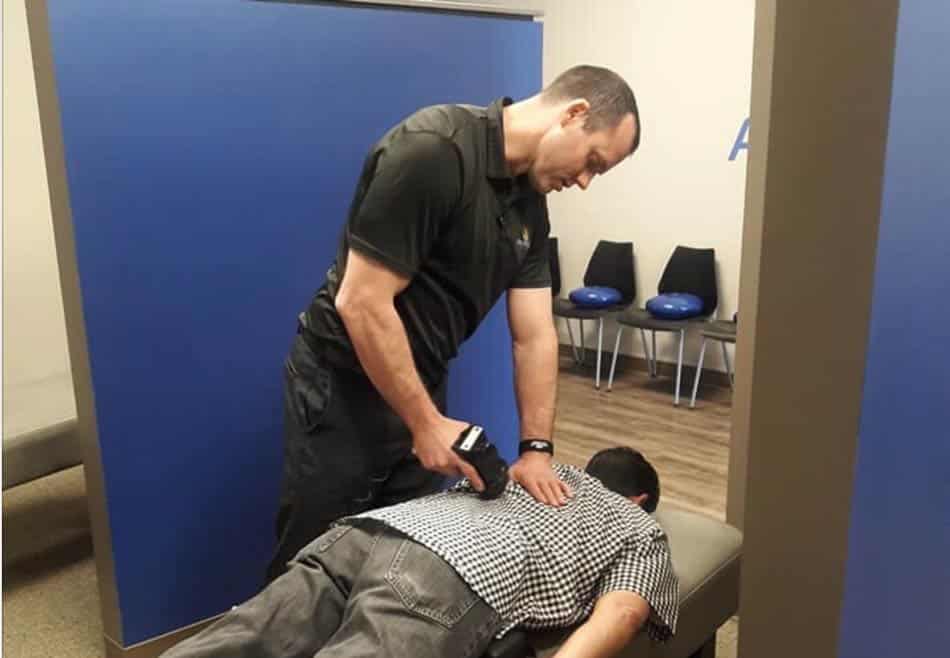What Is Whiplash?
In an accident where a car gets struck from behind, it lurches forward, throwing the passenger’s head back and forth violently, resulting in whiplash.
Whiplash is when the soft tissues in your neck are stretched beyond their normal range of motion. In extreme cases, injuries may cause brain, muscle, tendon, or bone damage.
If you are experiencing the symptoms of a whiplash injury, it’s important to seek medical care as soon as possible. Here at Thrive, we can provide diagnosis and care for many whiplash injuries.
Whiplash is a neck injury brought on by the head moving violently back and forth, much like cracking a whip, usually from a car accident.
Whiplash injuries and symptoms may include the following:
• Stiff Neck and Pain
• Numbness or Tingling in the Arms
• Dizziness or Vertigo
• Anxiety
• Memory Loss
• Chronic Headaches
• Pain in the Arms, Upper Back, or Shoulders
• Fatigue
• Ringing in the Ears (Tinnitus)
What Causes Whiplash Injury?
Whiplash injuries occur when the head snaps quickly backward and then forward, causing the muscles or ligaments in the neck to become strained. A very abrupt stopping or side to side motion, from a roller coaster to a go-cart ride to a car wreck, can cause this common injury.
The Most CommonCauses of Whiplash:
Car Accidents
Collisions or sudden acceleration or deceleration from an accident cause most whiplash injuries. If there was no head restraint, the injury will be worse.
Physical Abuse
Hard shaking or a forceful strike can cause whiplash. Shaken baby syndrome causes frequent neck injuries.
Contact Sports
Collisions often cause whiplash injuries between players that decelerate quickly and forcefully snap the head or neck forward or backward.
Falls
Any accident or fall where the head violently jerks backward or forward can cause a whiplash injury.
What Are the Symptoms of Whiplash?
There are four phases of whiplash symptoms patients can exhibit, from a mild strain to fractures. Any neck pain, shoulder, or back pain may be a Phase 1 symptom. The pain can range from a simple strain to a fracture or dislocation in severe Phase 4 cases. Chronic pain in the neck or shoulder areas should not be ignored. Chiropractors see great results when treating these issues.
Neck Pain and Stiffness
Whiplash can cause a persistent, throbbing ache that gets worse as you move your head up and down or side to side.
Headaches
Many whiplash victims get headaches. They typically surface a few days or weeks after the injury.
Dizziness
Whiplash may lead to dizzy spells, as though you’re spinning or about to fall.
Blurred Vision
Blurred vision can be caused by whiplash, but it can also be a sign of something more serious, like a concussion or traumatic brain injury.
Constantly Fatigued
Your body exerts considerable effort to relieve discomfort when you experience whiplash. As a result, even if you sleep a lot, you could feel more exhausted than usual. Sleep deprivation brought on by whiplash may also occur if lying down is uncomfortable due to neck pain.
What Are the Long-Term Effects of Whiplash?
Months or even years after the incident, some people still experience discomfort and other symptoms while performing daily activities. The severity of the impact may also result in the risk of brain damage or torn muscles in the neck, shoulder, or upper back that are hard to recover from.
When left untreated, whiplash injuries from an accident or for any other reason, can become chronic and last for years, or even your entire life. A doctor should diagnose your injury before treatment. Chiropractors can help your body heal naturally.
Possible Long-Term Effects May Include:
• Dizziness
• Chronic Neck Pain
• Shoulder Pain
• Stiffness, Pain, , Limited Movement, or Inflammation
• Chronic Lower Back Discomfort
• Suffer from Headaches
• Ringing in the Ears (Tinnitus)
• Depression
What Should You Do After a Whiplash Injury?
If you’re suffering from any injury, the first rule is to seek immediate care, especially if you were in an accident. If you have arm numbness or weakness, see a doctor at once. A doctor will decide, in severe cases, if your injury requires surgery. Chiropractors can help you heal without surgery or medication.
Patients typically get relief from whiplash symptoms within the first three months of treatment and therapy. The length of your recovery depends on the severity of your physical injuries. Chiropractic care can also promote healing sore muscles and neck pain.
Alternative Treatments for Whiplash:
Chiropractic Treatment
Alternating Ice and Heat
Gentle Stretching
Massage
Acupuncture
Essential Oils
Meditation
CBD Oil
Is a Whiplash Injury Serious?
When left untreated, severe side effects like stiffness and loss of motion can happen. Whiplash that isn’t treated can lead to misaligned vertebrae, cervical spine issues, or degenerated discs, as well as ongoing neck pain and stiffness. Chiropractors specialize in these types of injuries.
Thrive Spine Center in Folsom, CA
Helping people attain optimal health is our top priority at Thrive Spine Chiropractic Center in Folsom. We treat all types of chronic ailments, including back pain, neck pain, lower back pain, sciatica, carpal tunnel syndrome, headaches, migraines, and more, with our comprehensive chiropractic approach.
No matter how severe the pain is, from an accident or other injury, our patients get the finest treatments and Chiropractic care possible. If you need treatment, contact us today!
Conclusion
At Thrive Spine Center, we believe that the body has a remarkable capacity for self-healing. It is an organism capable of self-healing from injury and damage. With gentle Chiropractic treatment, our goal is to remove the obstructions that prevent our patients from healing quickly and naturally, so they can get back to enjoying their lives.
>


